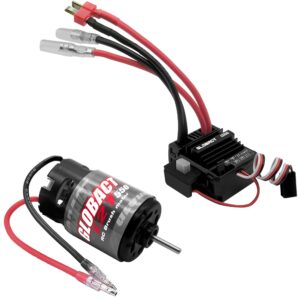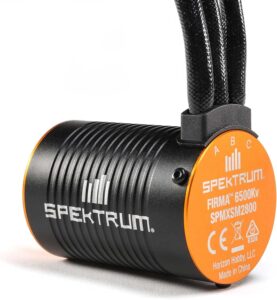At the heart of every great RC vehicle lies its motor – an engineering marvel that converts electric energy into blazing fast RPMs. When it comes to electric motors for radio controlled models, you have two main options: brushed or brushless. At first glance, they may seem similar. But under the hood, these motors operate quite differently, each with their own advantages and drawbacks. In this post, I’ll dive into the nitty gritty differences between brushed vs brushless RC motors. You’ll learn how each design works, key benefits and limitations, and which applications they are best suited for. Whether you’re new to the hobby or an experienced RC guru, you’re sure to discover some helpful insights.
Brushed RC Motors
Brushed motors have been powering RC vehicles since the early days of the hobby. Their simple, time-tested design makes these motors extremely accessible, especially for beginners.
Inside a brushed motor, you’ll find coils of wire surrounded by magnets. As current flows into the coils, it creates a magnetic field that pushes against the permanent magnets, causing the motor shaft to spin. The key ingredients are the commutator and brushes. The commutator is a cylinder divided into contact segments that alternate the current direction in the coils. The brushes press against the commutator to deliver power, effectively switching the magnetic poles and keeping the motor spinning.
Brushed motors are easy to understand and repair. Pop off the cover, inspect the brushes and commutator, maybe swap in some new brushes – and you’re often good to go again. Their simple construction also makes brushed motors relatively affordable. When budget is a big consideration for your project, brushed can be ideal.
These conventional motors also offer excellent torque at low RPMs. So for applications like rock crawlers or heavily geared designs, brushed motors provide ample low-end grunt to power through. Their durability and proven track record also instill confidence.
However, brushed motors do have some downsides. All that physical contact between the brushes and commutator creates electrical noise and resistance. This inefficiency means more wasted energy in the form of heat. Brushed motors generally can’t reach the crazy high RPMs of advanced brushless setups. And those brushes will eventually wear out from all that friction, requiring replacement.
Brushless RC Motors
Brushless motors represent an exciting modern development for RC. Ditching old-fashioned brushes and commutators, these motors take advantage of powerful electronics to unlock game-changing potential.
Inside a brushless motor, you’ll find permanent magnets surrounded by coils of wire. An electronic speed controller switches power to the different coils to rapidly alternate the magnetic fields. This electronic commutation eliminates all that friction while enabling precise control.
By eliminating electrical resistance and noise, they are vastly more efficient. This means less wasted energy and heat generation – allowing for better acceleration and cooling.
Maintenance is also greatly reduced without brushes and commutators to wear out. The high-tech electronics do come at a premium cost. And some complexity is added – you’ll need programmable ESCs capable of handling brushless operation. But for maximum performance, brushless can’t be beat.
The precision control enables some really clever functions too. Sensored brushless setups use Hall effect sensors to track rotor position for optimized timing. And sensorless types measure subtle back-EMF signals to self-regulate – ingenious!
While brushed motors have the simplicity factor, brushless takes the win for outright speed, power, efficiency, and cutting-edge performance. For hardcore RC enthusiasts chasing every last ounce of power, brushless offers the ultimate adrenaline hit.
Comparison Between Brushed vs Brushless RC Motor
When it comes to dollars and cents, brushed motors are the clear value choice. Their simple construction keeps costs down, making brushed the budget-friendly option. However, all those brushes and commutators will wear out eventually – requiring fairly frequent maintenance and replacement expenses down the road.
In terms of sheer power, brushless motors dominate. By eliminating friction losses and electrical noise, they can reach jaw-dropping RPMs and torque figures that would cause a brushed motor to cry uncle. Pound for pound, brushless puts out significantly higher maximum power – no contest.
Speaking of crying uncle, maintenance is another area where brushed motors pay the price. The continual mechanical contact between brushes and commutators causes significant wear. Brushes must be inspected and replaced routinely to keep brushed motors running at their best. Brushless motors eliminate this friction and upkeep.
Finally, brushless operation is remarkably quiet and cool relative to good ‘ol brushed. Without sparking brushes and resistance building heat, brushless motors hum along smoothly and efficiently. Your ears and fingers will appreciate the reduced noise and temperature.
So while the initial price may be hard to swallow, brushless motors deliver where it really counts – sheer power, minimal maintenance, and head-turning operation.
Recommendation of Brushed vs Brushless RC Motor
If you’re just getting your feet wet in RC, brushed motors offer an affordable and approachable option. Their simplicity also makes brushed motors ideal for low-speed crawler rigs or basic builds on a budget.
However, for maximum thrills and performance, I always reach for brushless power. The instant response and face-melting speed of good brushless setups can’t be matched. Maintenance is also kept to a minimum – more time for enjoying the ride.
For casual RC fun, brushed motors get the job done. But once you get hooked and start eyeing races and high-speed applications, the power and efficiency of brushless becomes downright addictive.
No matter your experience level or budget, there’s a capable RC motor option out there. My advice is to match the motor technology to your needs and have a blast pushing these machines to their limits! Start with brushed while you learn the ropes, then upgrade to brushless as your skills progress.
Final Thoughts
When choosing between brushed vs brushless RC motors, consider your budget, experience level, and performance needs. Brushed motors are affordable and easy to maintain but have less power. Brushless motors are more expensive but provide extreme efficiency, speed, and low maintenance. For most hobbyists, starting with an affordable brushed motor to learn the ropes then upgrading to high-performance brushless as skills progress is a winning combination.
Enjoyed this guide of Brushed vs Brushless RC Motor? Then be sure to check out our other RC Rating guides.

